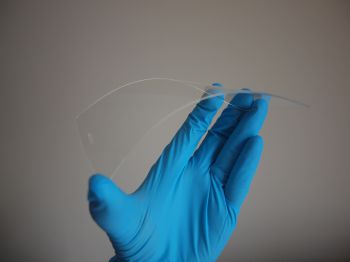New research shows how silver could solve issues of touch-screen technologies
By: Jacqui Bealing
Last updated: Wednesday, 11 May 2016

Physicists at the University of Sussex are developing a new material for touch-screen devices that has already proved to be more flexible and to have higher conductivity than current technologies.
Physicists at the University of Sussex are developing a new material for touch-screen devices that has already proved to be more flexible and to have higher conductivity than current technologies.
In collaboration with M-SOLV Ltd, a touchsensor manufacturer based in Oxford, Professor Alan Dalton and his team have shown that silver nanowires, which are more than a thousand times thinner than a human hair, are a viable alternative to the currently used material, indium tin oxide (ITO), which is expensive to source, expensive to process and – as anyone who has dropped their smartphone will know – very brittle.
Their research, which is published in the journals Materials Today Communications and Scientific Reports, looked to alternative materials to overcome the challenges of ITO, which is mined largely in China and Canada and is suffering from supply uncertainty.
Graphene, carbon nanotubes and random metal nanowire films are among the alternatives being explored. But this study, carried out while Professor Dalton was at the University of Surrey, showed how silver nanowire films have emerged as the strongest competitor, due to transmittances and conductivities that can match and readily exceed those of ITO.
Using a technique, called ‘ablation’, which involves the removal of material using a laser beam to produce individual electrode patterns, the team produced a fully operating five-inch multi-touch sensor, identical to those typically used in smartphone technology. They found it performed comparably to one based on ITO but used significantly less energy to produce.
Professor Dalton said: “Not only does this flexible material perform very well, we have shown that it is a viable alternative to ITO in practical devices. The fact we are able to produce devices using similar methods as currently in use, but in a less energy-intensive way is an exciting step towards flexible gadgets that do not just open the door for new applications, but do so in a much greener way.”
The team also showed that using ‘ultrasonication’, which involves applying high-frequency sound to the material to manipulate the length of the nanosized rods of silver, they could tailor the properties for a range of other applications.
Matthew Large, the first author on the research published in Scientific Reports, said: “Our research hasn’t just confirmed silver nanowires as a potential replacement touchscreen material, but has gone one step further in showing how ultrasonication can allow us to tailor performance capabilities.
“This allows us to tune how transparent or how conductive our films are, which is vital for optimising these materials for future technologies like flexible solar cells and roll-able electronic displays.”
Maria Cann, a technologist from M-SOLV and first author on the Materials Today Communications paper added: “We are seeing a lot of interest from our customers in silver nanowire films as an ITO replacement in devices. This work is a really important step in establishing exactly which sensor designs can make good nanowire products. The fact that the nanowire films are processed by the same laser techniques as ITO makes the transition from ITO to nanowires really straightforward. It won’t be long before we are all using nanowires in our electronic devices. ”
The team, who moved from the University of Surrey to the University of Sussex this year, are now looking to develop the scalability of the process to make it more industrially viable. One limiting factor is the current cost of silver nanowires. Funded by Innovate UK and EPSRC, the team are collaborating with M-SOLV and a graphene supplier Thomas Swan to use a nanowire and graphene combination in the electrodes to markedly reduce the cost.
